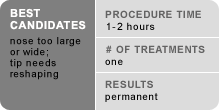Maybe you have been unhappy with your nose for as long as you can remember, or perhaps you are having difficulty breathing; either way, a Rhinoplasty or nose reshaping may be an option for you.
A Rhinoplasty can change many things about your nose, including your nose size (in relation to your face), nose width at the bridge, the size and position of the nostrils, and nose profile (by downsizing visible humps, bumps or depressions on the bridge)
A Rhinoplasty can also reshape the nasal tip, improve the appearance of large, wide or upturned nostrils and correct nasal asymmetry. From a functional standpoint, a Rhinoplasty can correct certain breathing difficulties such as those due to a deviated septum. Rhinoplasty is also an option for certain birth defects or noses that have been injured in car or sports accidents
Rhinoplasty Defined
A Rhinoplasty or nose job is a surgical procedure designed to reshape the nose. It can be done to correct a structural deformity (such as a bump or hook), provide subtle changes to nose size and shape to improve your appearance or to correct a functional problem (such as difficulty breathing due to a deviated septum).
The septum is the wall between the two nostrils. Composed of cartilage and bone, it divides the nasal cavity into halves. The ideal nasal septum is straight, separating the left and right sides of the nose into passageways of equal size. In contrast, a deviated septum occurs when the septum is severely shifted away from the midline. In severe cases, a deviated septum may cause difficulty breathing through the nose.
Types of Rhinoplasty
Primary Rhinoplasty is a nose-reshaping plastic surgery. Two types of primary Rhinoplasty include "open" and "closed":
Open Rhinoplasty. For major nose reshaping, the incisions are made in the vertical strip of skin separating the nostrils. This is called the columella. The skin and soft tissue are then elevated off the underlying structures of the nose so the surgeon can see the nasal anatomy.
Closed Rhinoplasty. For minor reshaping, many surgeons make incisions within the nose. The skin of the nose is then separated from the bone and cartilage, which form its supporting framework. Once exposed, bone and cartilage can be removed, reshaped, augmented or rearranged to achieve the desired new shape.
Secondary Rhinoplasty. Also called revision Rhinoplasty, this is performed to correct problems that persist or develop after a previous Rhinoplasty. Although the problems may be minor and easily corrected, often the problems are major, which makes the secondary Rhinoplasty more difficult. Secondary Rhinoplasty can also be done as an open or closed procedure.
Filler Rhinoplasty. This involves the use of injectable fillers to fill depressions, smooth out sharp angles or change the angle of the tip of the nose, restoring symmetry and making your nose appear smaller and more attractive. Instead of removing a bump, a surgeon would use an injectable filler to even it out. The results are not permanent.
The Rhinoplasty Procedure
Most rhinoplasties are performed on an outpatient basis in a hospital or surgical suite. Exactly how long the procedure takes depends on the type of Rhinoplasty that is performed. For example, a primary Rhinoplasty normally requires one to three hours in surgery, while a secondary Rhinoplasty can take much longer. A filler Rhinoplasty can take just 15 minutes.
Anesthesia. Dr. Hart will likely recommend local anesthesia with some sedation or general anesthesia for your primary Rhinoplasty. A secondary Rhinoplasty will often involve general anesthesia due to the complexity of the procedure. A filler Rhinoplasty requires just local anesthesia.
The Incision. Surgery of the nose is performed either using a closed procedure (where incisions are hidden inside the nose), or an open procedure (where an incision is made across the columella). Dr. Hart then raises the soft tissues that cover the nose through these incisions. This provides access to reshape the structure of the nose.
The Reshaping. Dr. Hart can reduce or augment nasal structures with cartilage grafted from other areas of your body. These pieces of cartilage can come from the septum or occasionally from the ear or the rib cartilage. If the septum is deviated, it is now straightened, and the projections inside the nose are reduced to improve breathing.
Closing the Incision. Once the underlying structure of the nose is sculpted, the nasal skin and tissue are redraped and the incisions closed.


